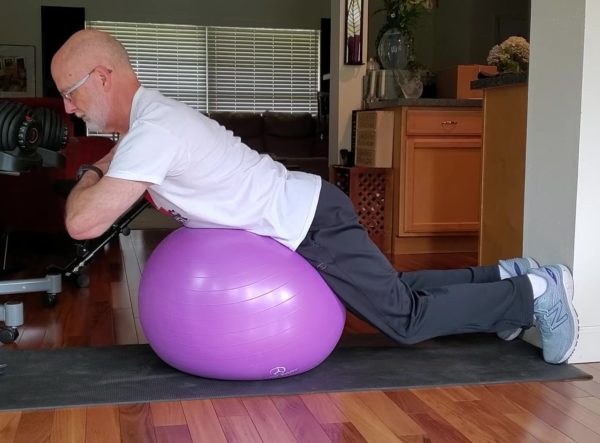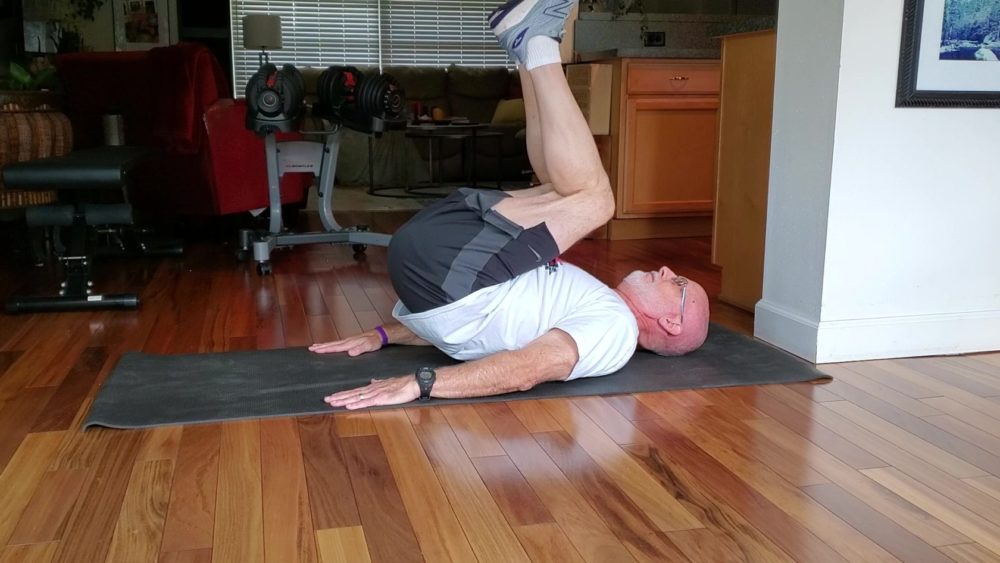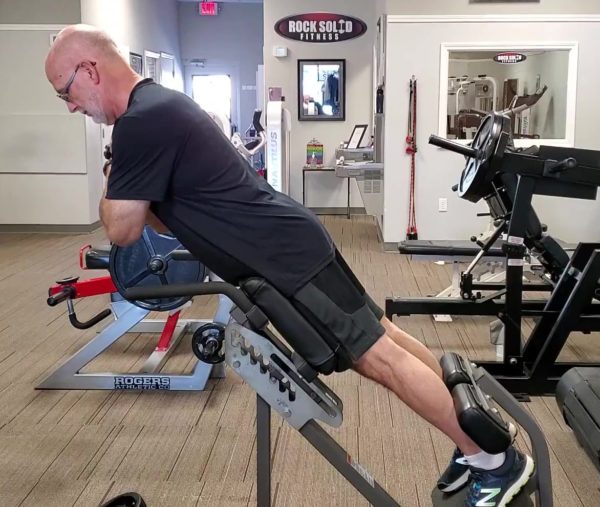Abdominal Exercises for Seniors: Safe and Effective Methods for staying strong and reducing back pain
As we age, it’s important to maintain as much full-body strength as we can, which includes the abdominal muscles. Consistently performed abdominal exercises for seniors are an essential addition to your fitness routine, keeping you feeling strong and confident in your daily activities.
Working on your abdominal strength can provide numerous benefits for seniors, such as reduced back pain, better posture, and improved mobility.
However, there’s a lot of controversy and misconceptions contained in the information available to people about how they should exercise their abdominal muscles. For the average senior, it can all be very confusing, causing time to be wasted on ineffective methods at best, and at worst causing injuries.
That said, there are abdominal and low back exercises for seniors that are both safe and effective. Properly performed, these exercises focus on improving your midsection strength without causing excessive strain on your joints or lower back.
This post will go over the importance of abdominal exercises for seniors, the truth about “core” exercises, planks, and abdominal fat loss, and how to do some simple, safe and sustainable abdominal and low back strengthening exercises at home or in the gym.
Related content on abdominal exercises for seniors:
- Weightlifting for Seniors: Safely Enhancing Strength and Fitness and Boosting Quality of Life
- Senior Fitness – My Video Interview On The Beyond Retirement Podcast
- Subscriber Q and A Video: 5 Great Free Weight Exercises For Over 50
- These Are The Best Exercises For Over 50 And Out Of Shape You Can Start Doing Today
Importance of Abdominal Exercises for Seniors
The muscles of the midsection are responsible for producing many movements that are essential in everyday life – like bending forward, arching the back, lifting the knees, and rotating the trunk.
In addition, these muscles serve to bolster and protect the lumbar spine during daily activities as well as sports and leisure pursuits such as golf, tennis, pickleball, hiking and fishing.
When choosing which abdominal exercises to include in your weekly exercise routine, it’s essential to start at a level that is comfortable for you and gradually progress as your strength increases. Listen to your body and make any adjustments necessary to ensure the exercises are both challenging and safe. With patience and dedication, you will find that incorporating abdominal exercises into your routine can make a positive impact on your health and quality of life.
It’s crucial to remember that consistency is key, and incorporating these exercises into your routine can lead to long-term improvements in your overall health and well-being.
What Are The Easiest And Most Effective Abdominal Exercises For Seniors?
Going back to what movements the abs and low back are responsible for tells you how to strengthen them – you strengthen them by performing that movement against resistance.
When you look at it that way, it’s pretty clear that standing on a wobbly surface while doing an arm exercise doesn’t qualify. But things like that is often portrayed as “core strengthening exercises”.
Here’s a simple way you can subjectively know if something is a good for strengthening your abdominals:
If you don’t feel it in your abs, it’s not for your abs.
The best way to safely strengthen your abdominal and low back muscles is to perform the movements that require those muscles to contract through a full pain-free range of motion with resistance. Boring, I know. But it works.
By incorporating safe and effective abdominal exercises into your exercise routine, you will be taking proactive measures to maintain your strength, mobility, and overall quality of life. We’ll cover a few good ones in a moment.
How Can Seniors Flatten Their Stomach?
It’s important to realize that there is no such thing as “spot reducing” – meaning you can’t exercise away abdominal body fat by performing abdominal muscle strengthening exercises. Losing body fat, no matter where it’s stored on your body, requires calorie reduction (don’t kill the messenger 😇).
So the best exercise for losing abdominal body fat is: pushing yourself away from the dinner table 😁.
2 Problems With “Core” Strengthening
The word “core” seems to be everywhere nowadays when speaking of exercise. It seems everywhere we turn, we are told about the critical importance of strengthening our “core muscles”, and how important having a strong “core” is for improving such things as balance, mobility, fall risk, stability (whatever that means), and the list goes on and on.
In my online strength training courses or discussions with my virtual coaching clients, I never use the word “core” when speaking of exercise.
When I think of the word “core”, 2 things come to mind:


Problem #1: Nobody agrees on what actually makes up the “core”, or where it stops.
There is no clear-cut universal definition of exactly which muscles comprise the “core”, and which ones don’t. If you do an internet search for “what are the core muscles?”, and read the top 10 results, you’ll see what I mean.
Problem #2: The way “core” strength is commonly described implies that having a strong “core” is more important than training your other muscle groups.
But as we all know, a chain is only as strong as it’s weakest link. You can have the strongest abdominal and low back muscles in the world, but if you tear your rotator cuff it’s still going to be a huge problem for you.
That’s why it’s a mistake to declare any one muscle group as most important. I advocate full body strength training, from head to toe and fingertip to fingertip.
Exercises for Abdominal Strengthening
As a senior, it’s important to focus on low back and abdominal strengthening to maintain a high level of pain-free function.
In this section, we will cover two effective exercises that target the rectus abdominis, transverse abdominis, internal and external obliques, as well as other abdominal muscles.
Remember, if you have any medical conditions, consult with your healthcare provider or a reputable fitness professional before beginning any new exercise program.
Abdominal Crunches
Crunches are a classic exercise that targets your rectus abdominis and external obliques.
To perform the abdominal crunch, follow these steps:
- Lie on your back on a floor mat.
- Slowly lift your feet one at a time to bring your hips and knees bent to a 90 degree angle.
- Cross your arms over your chest and lift your shoulder blades off the mat by curling your chest toward your hips (2 seconds).
- Pause, slowly lower back to the starting position (4 seconds), smoothly change direction and repeat.
- You can hold a weight on your chest for extra resistance as needed.


Remember to breathe throughout the exercise – the best way is to exhale as you lift your chest and shoulders toward your hips.
Reverse Abdominal Crunches
Reverse abdominal crunches also target the rectus abdominis and oblique muscles, but as the name implies you are curling your knees toward your shoulders instead of the other way around.
To perform the reverse crunch, follow these steps:
- Lie on your back on your floor mat with your arms by your sides and knees bent at about 90 degrees.
- Bring your knees to your chest in 2 seconds, rolling your hips up off the mat as you do so, keeping your knees bent at the same angle during the entire movement.
- Pause, then slowly lower in 4 seconds, gently touch your heels on the floor, smoothly change direction and repeat.
- You can add ankle weights for extra resistance as needed.
What About Planks?
Planks involve supporting your body on your toes and elbows while keeping your back straight, kind of like a pushup position but on your elbows.
Based on this position, planks are murder on your shoulder joints, and as such are an inferior way to strengthen your abdominal muscles. I don’t recommend them.
Exercises for Low Back Strengthening
Lower back extension movements target the erector spinae (the muscles on each side of your lumbar spine), and the gluteus maximus (your butt muscles). These movements help in reducing lower back pain and supporting and protecting your lumbar spine.
45 Degree Back Extension
To perform the 45 degree back extension, follow these steps:
- Position your feet on the foot plate with the back of your ankles firmly against the ankle pad, about shoulder width apart.
- Position your upper thighs on the pad.
- With your back and legs straight, cross your arms over your chest.
- Lean forward as far as you can comfortably (4 seconds), smoothly change direction, then return to the start position (2 seconds).
- Pause at the top, and repeat.
- You can hold a weight against your chest for extra resistance as needed.
Back Extension on Swiss Ball
To perform the back extension on the swiss ball, follow these steps:
- While kneeling on your floor mat, position the soles of your feet against the bottom of a wall about shoulder width apart.
- Position your upper thighs and hips on the Swiss ball.
- Cross your arms over your chest and lean forward as far as you can comfortably, rounding your lower back over the Swiss ball in 4 seconds.
- Smoothly change direction and lift your upper body by arching your back until your back is straight and your shoulders are in line with your hips.
- Pause for 1 second, then return to the start position in 4 seconds, and repeat.
- You can hold a weight against your chest for extra resistance as needed.


By engaging in these exercises, you will help strengthen your midsection, reducing low back pain, and protecting yourself from future injuries.
Important Considerations for Senior’s Workouts
As you engage in abdominal exercises for seniors, it’s crucial to keep in mind some key considerations to ensure your workouts are safe and effective.
Warming up and Stretching
Before starting any physical activity, allocate some time for a proper warm-up. Warming up prepares your body for the upcoming workout by gradually increasing your heart rate and loosening your muscles. Simple warm-up exercises may include walking, light cycling, or light dumbbell movements.
After completing your workout is a great time to stretch. Focus on static stretching, holding each stretch pain-free for 10-30 seconds.
Proper Lifting Techniques
When performing other strength training exercises, it’s crucial to apply proper lifting techniques to avoid injury.
Here is what you should keep in mind:
- Maintain a neutral spine: Align your head, neck, and back in a straight posture to avoid adding unnecessary stress on your spine.
- Engage your abdominal muscles: Tighten your abdominal to support proper body position and minimize the risk of injury.
- Exhale while lifting: Breathing out when lifting helps prevent elevated blood pressure and helps you generate more force.
Remember, as you progress in your fitness journey, prioritize proper technique over the number of repetitions. This will help you prevent injuries and maximize the benefits of your abdominal exercises.
Conclusion – Abdominal Exercises For Seniors
Incorporating abdominal exercises into your fitness routine as a senior can lead to improved health, decreased low back pain and other injuries, and better overall functional performance.
By choosing the right exercises and ensuring proper form, you can experience numerous benefits and maintain an active lifestyle.
Remember to start with a level of intensity you can handle and gradually increase intensity as you become more comfortable with the movements.
On your non-strength training days, low impact activities can improve pulmonary function and overall health in seniors.
It is essential to consult with your healthcare provider or a reputable fitness professional before beginning any abdominal exercise program. This will ensure that the exercises you choose are safe and appropriate for your abilities and health conditions.
In addition, combining abdominal exercises with a well-rounded fitness program that includes full-body resistance training has been shown to have positive outcomes in the memory of cognitively healthy older adults.
By being consistent in your fitness efforts and staying open to modifications and adjustments, you can enjoy the many health benefits of abdominal exercises, stay active, and preserve your quality of life as you age.





6 Comments. Leave new
Thanks Dave! This is very timely as my lower back is barking at me again. Lol
Jim let’s see if these exercises will quiet that back down! Make sure to maintain good body positioning during your upper and lower body exercises too, and when grabbing or putting away dumbbells, to protect your back.
Thank you Dave! Love you guys.
Thank you Marlene! Love you too!
I exercise every morning, but I still have chronic lower back pain, particularly after bending to a half level and lifting fairly light weights. Any advice I am 83 going on 84
Hi Anthony, sorry to hear you’re dealing with that. One thing that’s important for your situation is to try to always have chest or back support when performing any upper body exercises. For example, having your chest supported by a bench or pad when performing rowing exercises, or at the very least arm support as in the 1 arm dumbbell row, vs. a bent-over barbell row with no support. Bending forward at the waist without any upper body support increases the pressure on your lumbar discs dramatically.
You also might benefit from a lumbar stabilization exercise program. There’s a video on how to get started with one in my free report, The New Rules of Strength Training Over 50, which you can get here.